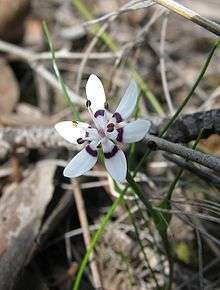Wurmbea dioica
| Early Nancy | |
|---|---|
 | |
| Wurmbea dioica in Paddys Ranges State Park, Victoria | |
| Scientific classification | |
| Kingdom: | Plantae |
| (unranked): | Angiosperms |
| (unranked): | Monocots |
| Order: | Liliales |
| Family: | Colchicaceae |
| Genus: | Wurmbea |
| Species: | W.dioica |
| Binomial name | |
| Wurmbea dioica R.Br. F.Muell.[1] | |
| Synonyms | |
|
Anguillaria dioica R.Br. | |
Wurmbea dioica (early Nancy) is a herb that is native to Australia, widespread across all 6 states but unknown in the Northern Territory.[2] This plant takes its common name from its tendency to appear as one of the first flowering species of spring, with flowers appearing late in August and lasting until early October. Preferring areas clear of other organic debris, it can be found rather easily in open, sub-alpine grassland, where the feeding activities of Eastern grey kangaroos allow sunlight to reach and warm the ground, triggering the end of their winter dormancy.
The species is dioecious, meaning individual plants are either male or female. Despite this, approximately 3–8% of plants may be cosexual (i.e. they contain both male and female flowers), their floral traits generally being intermediate to those of the males and females.[3] Males produce larger floral displays than females.
Despite being small and almost leafless, the species will rapidly colonise suitably sparse grassland, and can take only a few seasons to cover a large clearing in hundreds or thousands of small white flowers.
Description
W. dioica is a small perennial herb. Plants consist of a corm, two or three annual leaves, and a single inflorescence spike with one to eight flowers.[3] Flowers have six tepals 4–11 millimetres (0.16–0.43 in) long and are arranged in a single whorl.[3][4] Each tepal has a coloured nectary band near the base. Tepals are usually white with purple nectaries but can be greenish or yellowish with purple or greenish nectaries.[4] Flowers open acropetally on inflorescences and all flowers may be open at once.[3]
The fruit is a capsule containing 10–50 seeds.[3]
References
- ↑ "Wurmbea dioica". Australian Plant Name Index (APNI), IBIS database. Centre for Plant Biodiversity Research, Australian Government, Canberra. Retrieved 2008-11-01.
- ↑ Kew World Checklist of Selected Plant Families, Wurmbea dioica
- 1 2 3 4 5 Vaughton, Glenda; Ramsey, Mike (June 1998). "Floral display, pollinator visitation and reproductive success in the dioecious perennial herb Wurmbea dioica (Liliaceae)". Oecologia. Springer-Verlag. 115 (1): 93–101. doi:10.1007/s004420050495.
- 1 2 Harden, G.J. "Wurmbea dioica (R.Br.) F.Muell.". PlantNET—The Plant Information Network System of The Royal Botanic Gardens and Domain Trust, Sydney, Australia. Retrieved 7 September 2015.